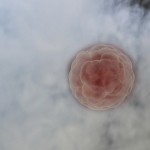The Disposition of Cryopreserved Embryos
 By Dr. Craig R. Sweet, Medical Director & Founder
By Dr. Craig R. Sweet, Medical Director & Founder
During in vitro fertilization (IVF), numerous eggs are removed from the woman, and fertilized with sperm to create embryos that are grown in the laboratory for several days. Almost always the final number of embryos available for transfer is less than the number of eggs (oocytes) originally retrieved from the woman.
For example:
- 12-14 oocytes retrieved
- 10-12 mature ooctyes (available for fertilization)
- 8-10 oocytes successfully fertilize with sperm
- 3-6 embryos survive and are available for transfer or storage in liquid nitrogen for future use

From the few embryos left on day five of fertilization, we try to transfer the smallest number needed to achieve a pregnancy. Approximately, one-third of the patients will have enough extra embryos to freeze for future use.
These embryos may last for decades frozen in liquid nitrogen (Mazur P, 1980). For many, deciding what to do with the embryos is a very difficult decision. In general, the following options exist:
- Thaw and transfer for personal use
- Donate to science
- — Human embryonic stem cell research
- — Other valuable studies
- Discard
- — Thaw and dispose
- — “Compassionate Transfer” into a uterus at a time when implantation cannot occur
- Donate to patients in need (i.e., embryo donation)
Many, but not all facilities, offer the “discard” option. We believe that better choices exist than destruction and no longer include it in our patient consents. The actual options available to a given patient may be more limited than the list above.
There are many reasons patients do not use the embryos for personal use (Kirkman M, 2003):
- They have completed their family
- Past pregnancy complications
- Age
- Emotional exhaustion
- Cannot afford further treatment
- Divorced
Many find deciding the next steps for their cryopreserved embryos to be exquisitely difficult. I feel that all reproductive facilities could perform far better at counseling patients and assisting them in making these decisions. Patients have complained that we haven’t done an adequate job (Nachtigall RD, et al., 2005). I suspect they are right. I believe it is the responsibility of the cryopreservation or reproductive endocrine facility to educate patients adequately and offer assistance and information when requested. EDI designed a brief brochure to address these very issues.
If one is really uncertain and the personal use of the embryos is still a possibility, then I agree that the embryos should be stored longer, but not indefinitely.  If, however, additional family building has been ruled out, then I advise the patient to take a deep breath and make the difficult decision that ultimately must be made.
If, however, additional family building has been ruled out, then I advise the patient to take a deep breath and make the difficult decision that ultimately must be made.
My patients put so much, emotionally and financially, into the creation of their embryos. Our goal is to support them through the difficult decision, no matter what they decide. I can only hope they will consider either human embryonic stem cell research or embryo donation. I personally believe embryos deserve a heightened level of respect. These two possible destinations serve a common and greater good for everyone involved. While human embryonic stem cell research holds some future promise, the immediacy of growing a family though embryo donation seems to be the best choice for those wonderful and precious gifts, a donors’ embryos.
Craig R. Sweet, M.D.
Founder, Embryo Donation International
Reproductive Endocrinologist
Medical & Laboratory Director
References:
- Kirkman M. Egg and Embryo Donation and the Meaning of Motherhood. Women & Health 2003;38(2):1-18.
- Mazur P. Limits to life at low temperatures and at reduce water contents and water activities. Orig Life 1980:10(2):137-59.
- Nachtigall RD,et al. Parents’ conceptualization of their frozen embryos complicates the disposition decision. Fertil Steril 2005;84:431-4.